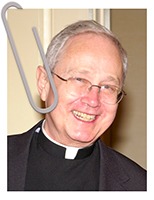A recent story by Patricia L. Guilfoyle, Editor. the Catholic News Herald begins with “The rainbow. In the Old Testament, it is the symbol of God’s covenant with His people. St. Mary’s Church in Greensboro has adopted the same symbol to represent the diverse beauty of many races and colors – one, holy, Catholic people – united in worshipping and serving God.”
During a recent visit to our Provincial Motherhouse, I had the privilege to get initial reactions of Fr. William Allegretto, CM to his new responsibility of serving a diverse population In Greensboro. They are a people united in worshipping and serving the St. Mary’s rainbow of cultures into one loving community.
His immediate response was “Coming into a multi-cultural and diverse parish is coming into what I’ve always believed the church is and has yet to become in the United States.”
The growth and the mixing of long-time black parishioners and immigrant newcomers – many of whom struggle with learning English and navigating American culture – has not always been easy. And now it is the pastor who has the struggle to cope with the many languages and cultures. But he explained to his people, “The language I will speak is that of our Lord – a language of the heart, kindness, concern, care, and mercy.”
Today St. Mary’s boasts more than 2,000 members from nearly every continent on Earth. The anniversary celebration Sept. 23 reflected that diversity, with the Mass being celebrated in English, Spanish and Vietnamese. Three Vincentians took turns delivering the homily in all three languages. Father Allegretto is only fluent in English. Vincentians have long encouraged the various ethnic and racial groups to mingle, get to know one another, and serve God and one another together adding Masses in other languages.
Founded in 1928 the parish’s longest-serving member, 83-year-old Virginia Smith, has witnessed the St. Mary’s community grow and change over the years. She was baptized at the church in 1937 two years before the Vincentians of the Eastern Province assumed responsibility for the Parish.
She serves as a kind of oral historian of the “changing” of the neighborhood. For her diversity of St. Mary’s is not a recent phenomenon. Decades before immigrants from Mexico and Central and South America moved to the Greensboro area, the parish experienced influxes of immigrants from Nigeria and other African countries, as well as Vietnamese, Montagnard and Hmong newcomers. But the first wave of change came with integration in the wake of the 1964 Civil Rights Act.
“Back in the day, it was not a multicultural church. It was our colored mission,” Smith recalled. Then, with a hint irony, “a whole slew of white people came,” transferring from New York with Western Electric after World War II and integrating after new parish boundaries were set in the 1970s.” As the parish became more diverse, Smith noted, “a lot of people left.” But not her. “I’ve got no problem with multiculturalism. We are all one. God made us all. That’s just the way I feel.” It’s all I ever know,” she added, then laughed. “I’m Catholic born, I’m Catholic bred, and when I die I’ll be Catholic dead.”
The growth and the mixing of long-time black parishioners and immigrant newcomers – many of whom struggle with learning English and navigating American culture – has not always been easy, parishioners acknowledged.
On September 27th celebration of the feast of St. Vincent, parishioners David Cao, Bruit K’Bruit, Joseph Kakhu and Sister Delores Espitia – representing the various cultures of the parish – wished outgoing pastor, Vincentian Father Charles Strollo, well on his future ministry with the Vincentian order and welcomed Father Allegretto as incoming pastor.
Thoughts from his homily
In his turn, Father Bill Allegretto, pastor, reminded the congregation of the parish’s segregated history, when black Catholics in Greensboro “built a refuge – not a fort, but a refuge – a safe harbor, a dwelling place where God’s love can be found again and again and again.” “They did it in the face of oppression. They did it in the face of resistance. They did this in the face of violence,” Father Allegretto said. “They wanted to give back to the Lord for all that He did, and they did it with grateful hearts,” he said. “They did it with hearts of how to love in the face of destruction, and dismissal, and diminishment.”
He continued, “We are here because of those efforts, because what they did was to create a legacy for all of us to sit here together. How many churches can sit here together with so many different faces of our God’s reflection? Even though we communicate differently, even though we speak from a different culture, from a different pathway, we come because we believe that we have one Lord, one faith, and one baptism.”
“We know who we are, we know where we have come from, and we know where we’re going, don’t we? We know we are God’s people, and we’re going to continue to be God’s people because of what happened 90 years ago and what has been built every generation since then,” he said. “Our ancestors – and I will say, our ancestors – gave us a legacy, gave us the hope to gather as a Catholic people from many cultures, many traditions.”
That unity in diversity – symbolized by the parish’s rainbow – is something St. Mary’s members take great comfort in, several people said.
Parishioners proudly sang the gospel hymn “We Shall Overcome,” a key anthem of the civil rights movement, at the recessional before congregating in the narthex and outdoors on the lawn to socialize, give thanks and celebrate their unique yet shared heritage.
Many thanks to Patricia L. Guilfoyle, editor for the substance of this article and photos.
The article provides an excellent history at the end.


I am so blessed to be touched by Saint Mary’s and the Congregation of the Mission!
Ed Ambrose,AA,St. Joe’s,1957